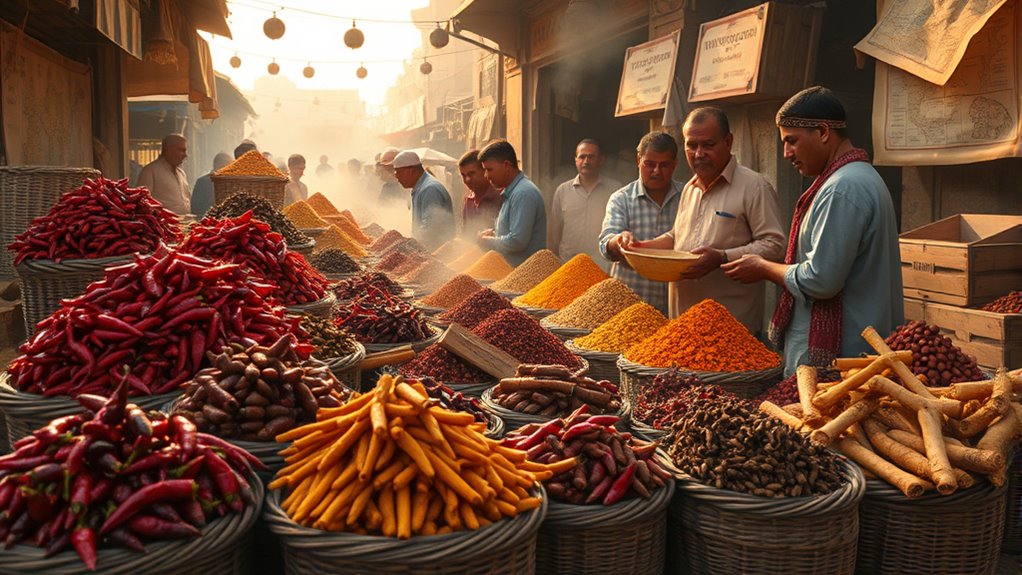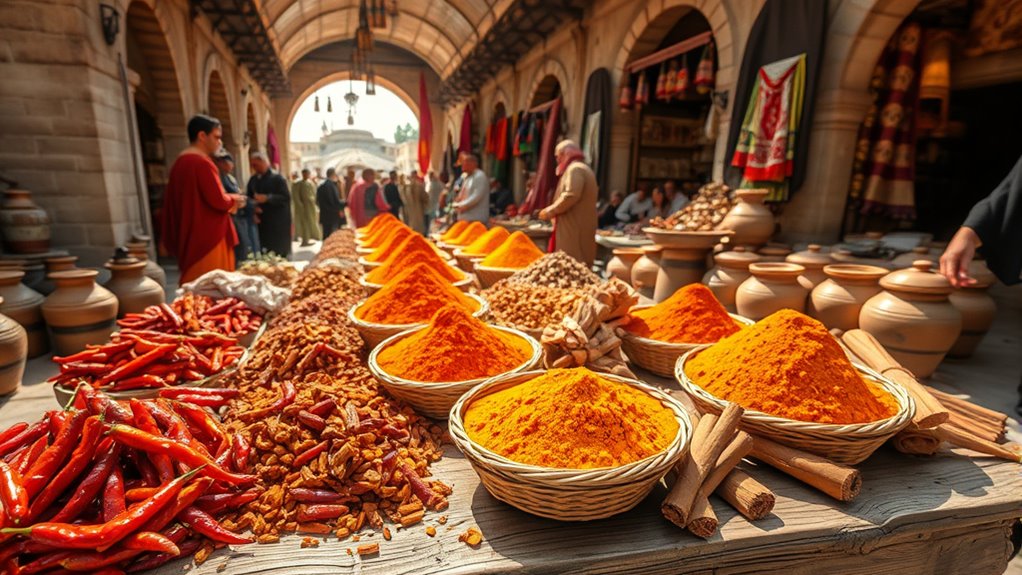The history of spices and their trade routes shows how they transformed civilizations and inspired exploration. Ancient traders risked long journeys across deserts, jungles, and oceans to obtain rare spices like pepper, cinnamon, and cloves, boosting wealth and power. Maritime routes connected the Spice Islands to Europe, Africa, and Asia, spreading not only goods but ideas and cultures. This vibrant trade shaped economies and inspired explorers, leaving a legacy that continues today—if you explore further, you’ll uncover even more fascinating details.
Key Takeaways
- Ancient civilizations used spices for flavor, preservation, and medicine, elevating their status as symbols of wealth and power.
- The spice trade involved perilous land and maritime routes, connecting Asia, the Middle East, Africa, and Europe.
- Maritime routes from the Maluku Islands facilitated cultural exchange and economic growth in port cities like Venice and Genoa.
- The high demand for spices spurred European exploration, leading to discoveries like Columbus’s voyage and new trade routes.
- Spices significantly impacted global history, transforming economies, cultures, and shaping modern trade networks.

Have you ever wondered how spices became some of the most valuable commodities in history? It all started thousands of years ago when ancient civilizations realized that certain herbs and seeds could enhance flavor, preserve food, and even serve medicinal purposes. As demand grew, traders began seeking out these fragrant treasures, sparking a network of trade routes that would shape history.
Spices like black pepper, cinnamon, cloves, and nutmeg became so prized that they were worth their weight in gold. Their rarity and the difficulty of obtaining them elevated their status, making them symbols of wealth and power.
Spices such as black pepper, cinnamon, cloves, and nutmeg once symbolized wealth and power due to their rarity and value.
You might be surprised to learn that the journey of these spices was long and perilous. Traders had to traverse deserts, jungles, and mountain passes, often facing bandits, harsh climates, and unfamiliar territories. The Silk Road, famous for connecting China to the Middle East, became an essential route for spice trade, enabling merchants to carry their goods across vast distances.
Similarly, the maritime routes that emerged later, especially around the Indian Ocean, allowed spices to flow from the spice islands—such as the Maluku Islands—toward Europe, Africa, and Asia. These routes weren’t just about commerce; they facilitated cultural exchanges, spreading ideas, religions, and technologies along with the spices.
The spice trade didn’t just benefit merchants; it transformed entire economies. Coastal cities and port towns flourished as hubs of commerce, attracting merchants from distant lands. Venice and Genoa, for example, became wealthy centers thanks to their control over spice imports.
European monarchs and wealthy elites paid hefty sums for these exotic flavors, fueling a demand that kept the trade alive. This high demand led European explorers to seek new routes, eventually culminating in Columbus’s voyage and the discovery of the New World.
The quest for spices, consequently, played a key role in the Age of Exploration, opening up new worlds and trade networks. As you can see, the history of spices and their trade routes is intertwined with human ambition, exploration, and cultural exchange.
What started as a pursuit for flavor and preservation grew into a global economic force shaping civilizations. The legacy of this trade continues today, reminding us how a simple seed or herb once held the power to change the course of history.
Frequently Asked Questions
How Did Spices Influence Ancient Culinary Traditions Worldwide?
Spices greatly shaped ancient culinary traditions by adding unique flavors and aromas, transforming everyday dishes into memorable meals. You’d notice how different regions used local spices to create signature tastes, influencing cultural identities.
As spices became valuable trade commodities, they also encouraged culinary exchanges between distant lands. This blending of flavors led to innovative recipes, enriching global cuisine and making food more exciting and diverse in every corner of the world.
What Were the Environmental Impacts of Spice Cultivation?
Spice cultivation can cause significant environmental impacts, such as deforestation, habitat destruction, and soil degradation. When you grow spices intensively, you often clear land, which threatens local ecosystems and biodiversity.
Pesticides and chemicals used in farming can pollute water sources, harming wildlife and ecosystems. Plus, overharvesting spices can lead to resource depletion, making sustainable practices essential for protecting the environment while enjoying these flavorful treasures.
How Did Spice Trade Affect Regional Economies Historically?
You see, historically, the spice trade boosted regional economies by creating bustling markets and increasing exports. It encouraged the development of port cities, led to the rise of merchant classes, and spurred infrastructure improvements.
As you observe, this trade also introduced wealth and cultural exchanges. However, it sometimes caused economic imbalances, dependency on spice exports, and conflicts over control of trade routes, shaping the economic landscape of many regions.
Were There Any Significant Conflicts Over Spice Control?
Imagine a bustling marketplace where nations fought like fierce wolves over the prized spice trade. Yes, there were significant conflicts over spice control, from naval battles to wars like the Portuguese-Portuguese conflicts and the Dutch-Portuguese struggles.
These disputes often led to colonization and shifting alliances. The intense desire for exclusive access to spices fueled rivalries, making control of spice routes a matter of power, wealth, and national pride.
How Did Spices Impact Cultural Exchanges Between Civilizations?
Spices greatly impacted cultural exchanges by fostering trade, migration, and shared culinary traditions. When you explore different cuisines, you see how spices connect diverse civilizations, spreading ideas and customs.
They inspired art, healing practices, and religious rituals, creating a rich tapestry of cultural interactions. You can feel the influence of spices in everyday life, showing that they’re more than just flavor—they’re bridges that link civilizations across time and space.
Conclusion
So, savor the sensational saga of spices, shaping societies, steering ships, and sustaining stories. From fiery flavors to fabulous fortunes, spice trade routes sparked centuries of exploration, exchange, and empire-building. As you now know, these tantalizing treasures traveled through treacherous terrains and turbulent tides, transforming the world one pinch at a time. Stay curious, explore endlessly, and let the spicy saga of history spice up your own story of discovery.









